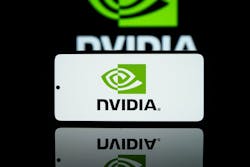NVIDIA Gets Really Serious About AI in the RAN
NVIDIA launched a new AI platform called AI Aerial designed to bring AI into the Radio Access Network.
The company is calling it an “AI-RAN platform capable of hosting generative AI and RAN traffic, as well as integrating AI into network optimization.”
AI Aerial includes hardware and software, and includes a software-defined RAN and training and simulation capabilities, along with a host of other features, with the aim to allow telcos to deploy the next generation of wireless networks.
What does it include?
The company’s programmable “Aerial CUDA-Accelerated RAN” touts the ability for partners to develop software-defined and cloud-native RAN networks and run virtualized RAN workloads on NVIDIA’s platforms.
The Aerial AI Radio Frameworks is software for enabling the capabilities of AI/ML, and neural networks into the RAN, by providing AI models to learn and improve in a network testbed designed to simulate a 5G network and improve efficiency.
The Aerial Omniverse Digital Twin is a simulation platform that does what it sounds like it does: allow for simulation of real-world 5G (and 6G) environments with a digital twin, extracting data from throughout the network to test, optimize, and improve it on a visual and collaborative platform. NVIDIA believes the platform can also be helpful in developing 6G standards.
NVIDIA says their currently partnering with T-Mobile, Ericsson, and Nokia on an “innovation center” to speed up commercialization of AI-RAN.
Additionally, NVIDIA is working with Softbank, Fujitsu, Northeatern University, Samsung, Dell, HP, and a host of software companies.
NVIDIA is clearly trying to stake an early dominance in integrating AI into the network with this platform. Now the question is if the other stakeholders involved in actually building out 5G and eventually 6G networks will make AI-RAN, or something like it, a reality and an essential part of the industry, or if that’s still too far out to see.
You can read more about NVIDIA’s AI-RAN platform launch on their blog.
About the Author
Joe Gillard
Executive Editor
Joe Gillard is a media professional with over 10 years of experience writing, editing, and managing the editorial process across a spectrum of innovative industries. Joe strives to deliver the best possible editorial product by focusing on the needs of the audience, utilizing the data available, and collaborating with a talented team.

